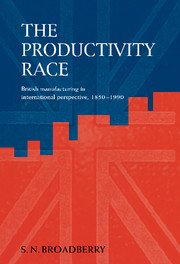Book contents
- Frontmatter
- Contents
- List of figures
- List of tables
- Acknowledgements
- Glossary of terms and company names
- 1 Introduction and overview
- Part 1 measuring comparative productivity performance
- 2 International comparisons of productivity in manufacturing: benchmark estimates by industry
- 3 Labour productivity in aggregate manufacturing: Britain, the United States and Germany
- 4 Extending the picture: manufacturing productivity in other industrialised countries
- 5 Manufacturing and the whole economy
- Part 2 explaining compartive productivity performence
- Part 3 reassessing the performance of British industry
- Bibliography
- Index
5 - Manufacturing and the whole economy
Published online by Cambridge University Press: 28 October 2009
- Frontmatter
- Contents
- List of figures
- List of tables
- Acknowledgements
- Glossary of terms and company names
- 1 Introduction and overview
- Part 1 measuring comparative productivity performance
- 2 International comparisons of productivity in manufacturing: benchmark estimates by industry
- 3 Labour productivity in aggregate manufacturing: Britain, the United States and Germany
- 4 Extending the picture: manufacturing productivity in other industrialised countries
- 5 Manufacturing and the whole economy
- Part 2 explaining compartive productivity performence
- Part 3 reassessing the performance of British industry
- Bibliography
- Index
Summary
Introduction
So far, we have concentrated on establishing levels and trends of comparative labour productivity in manufacturing, noting the persistence of a large US manufacturing labour productivity lead over both Britain and Germany, and broadly equal levels of labour productivity in the manufacturing sectors of the latter two economies. However, trends and levels of comparative labour productivity at the whole economy level have been very different. In this chapter we show that these diverse findings are consistent and consider some of the implications for our understanding of the processes of growth and convergence of living standards across nations.
Reconciling the manufacturing and whole economy estimates
The contribution of manufacturing
Care must be exercised in going from estimates of comparative labour productivity performance in manufacturing to comparative labour productivity performance at the whole economy level. The problem arises because of (a) differences between sectors in value added per employee and (b) differences between countries in the structure of employment. It has been noted at least since the writings of Clark (1940) and Kuznets (1946), that value added per employee tends to be substantially higher in the industrial sector than in agriculture and slightly higher again in the service sector. Hence it is theoretically possible for a country with a higher labour productivity in each of the three broad sectors to have lower labour productivity overall because of a greater degree of specialisation in the sectors with lower value added per employee.
- Type
- Chapter
- Information
- The Productivity RaceBritish Manufacturing in International Perspective, 1850–1990, pp. 63 - 74Publisher: Cambridge University PressPrint publication year: 1997



